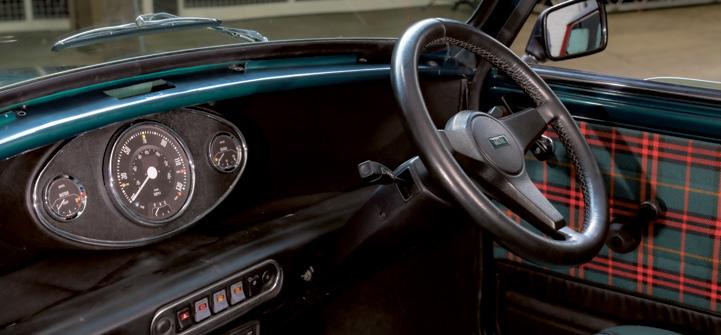
4 minute read
Auto news
drive
24 / AUTO NEWS 26 / CHANGEMAKERS: GOOD CAR CO. 29 / 0–100 REVIEW: LEXUS UX 300E 30 / ROAD TEST: AUDI E-TRON 37 / IN REVERSE: FORD THUNDERBIRD
Fries to go
One of Australia’s newest electric vehicles (EVs), the Polestar 2, has relied on chip fat to help it make the long-distance journey across the remote Nullarbor Plain. The stylish all-electric fastback launched here in February, priced from $59,900, and is available in a three-variant line-up with a choice of front or all-wheel drive and two battery sizes, the Long-Range single motor version boasting a range of 540km. The dedicated electric vehicle brand was founded by Volvo and Geely, and its first mass-market model, the Polestar 2, became one of the first EVs to trial a new bio-fuel EV charging station located at the Caiguna Roadhouse, 370km east of Norsemen and 370km west of the South Australian border. The BiØfil fast-charging point is designed to help plug the EV range gap between Western Australia and South Australia, and uses a generator powered by energy from waste cooking oil that’s recycled from the Roadhouse kitchen.
P For more visitpolestar.com/au
auto news. The latest developments in the car world
NUMBER CRUNCH Toyota hybrid technology
Last year marked Toyota’s 19th consecutive year as the best-selling automotive brand in Australia, with the Japanese giant delivering an industry-leading 223,642 new vehicles. The company chalked up a record 65,491 hybrid-electric vehicle sales. Here’s a snapshot of Toyota’s hybrid performance.
2001
The year Toyota’s first hybrid electric vehicle (HEV), the Prius, was released.
242,272 The number of HEVs Australian buyers have purchased since 2001.
72.3%
The percentage of RAV4 sales that were HEVs in 2021, amounting to 25,850 vehicles, making the mid-size SUV Australia’s top-selling hybridelectric vehicle.
30%
The percentage reduction in fuel consumption Toyota estimates its hybrids deliver on average, compared to the same vehicle with a conventional petrol engine.


Mini to the max
Created at the dawn of the Swinging Sixties, the original Mini rewrote the rule book for compact-car fuel consumption, space efficiency and performance. Fast-forward to today and the Mini is still a much loved and highly collectible classic, but its future in Europe is threatened by tightening emissions regulations and punitive congestion charges for internalcombustion-powered vehicles.
Now, a dedicated team at Mini Plant in Oxford, UK, have found a way to ensure the hits keep coming for the Mini by adding an electric powertrain. The Mini Recharged project swaps out the original petrol engine and replaces it with a modern electric motor that generates up to 90kW and accelerates the Mini EV from 0–100km/h in around nine seconds. The high-voltage battery enables a range of approximately 160km. The bespoke upcycling of the classic Mini is carried out exclusively in the United Kingdom and a spokesperson for Mini Australia said there were no plans to introduce the initiative here. For more visit mini.com.au

Aussies embrace electrics
Figures released by the Federal Chamber of Automotive Industries in January show that a total of 1,049,831 vehicles were sold across Australia in 2021, representing a 14.5% increase on 2020. Toyota was once again the best-selling brand, with 223,642 sales for 21.3% market share. Battery electric vehicles saw a 191.1% increase on 2020 with 5149 sales, or 0.49% of the overall market. The FCAI also reported 3372 plug-in hybrid and 38 hydrogen fuel cell EV sales. Australia’s best-selling electric vehicle brand Tesla does not submit sales figures to the FCAI but did share its data with the Electric Vehicle Council, which later released more complete figures showing a total of 20,665 plug-in electrics were sold in 2021, or 1.95% of new vehicle sales. The stats confirm the Tesla Model 3 as easily the country’s best-selling EV with 12,0954 sales, comfortably ahead of the second-placed MG ZS EV’s 1388 sales (pictured). For more visit fcai.com.au



What range anxiety?
Mercedes-Benz has unveiled what the company describes as the most efficient vehicle it has ever produced, an all-electric concept known as the Vision EQXX. With its low weight, low drag and sky-high efficiency the high-tech machine is said to be a clear pointer to where the German luxury car maker is headed with future production models. Boasting energy consumption of less than 10kWh per 100km, the Vision EQXX has a range of more than 1000km on a single charge, using a battery that has 50%t less volume and is 30% lighter than that of the Mercedes-Benz EQS, which has similar energy density. Translated into fossilfuel consumption, that is around 1.0L/100km, or put in distance terms, a single charge of the Vision EQXX will take you from Berlin to Paris, or closer to home, from Hobart to Burnie and back, via Queenstown, with 270km in reserve.
For more visit mercedes-benz.com.au
AUSTRALIAN MUSICAL THEATRE FESTIVAL

PERFORMANCES WORKSHOPS MASTERCLASSES FREE EVENTS SCHOOLS PROGRAM DANCE, ACT, SING ... & SO MUCH MORE!
Book at www.amtf.org.au or phone (03) 6331 0052
dev design










